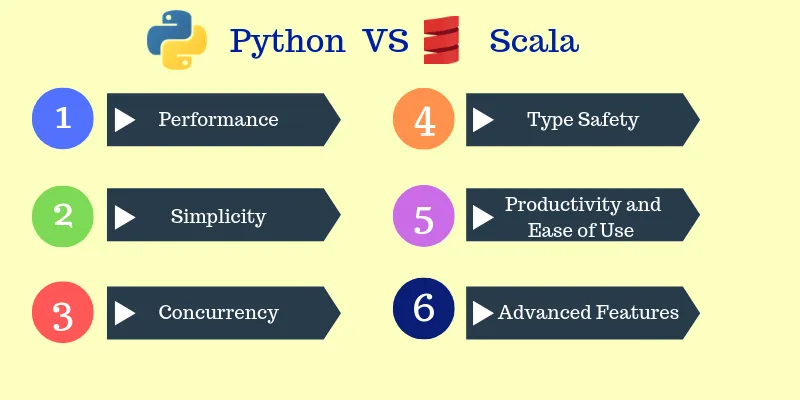Right now, Python and Scala are two of the most used languages for data science and big data. Though there are many other languages such as Java and R that are also doing a great job in data science, Python and Scala are at the forefront. Which one is better? Continue reading this detailed Python vs Scala discussion to know more.
With the advancement in machine learning and artificial intelligence, data scientists are providing a base structure for new ML models. When data is more valuable than money itself, data scientists are the main priority of many IT companies, so they can extract valuable information and boost business growth.
This article provides a comprehensive comparison between Python and Scala so you can choose the ideal programming language for your career. Before we compare these two programming languages, let's have a brief introduction to each of them.
Python vs Scala: A Head-to-Head Comparison Table
|
Factors |
Python |
Scala |
|
Definition |
Python is a general-purpose, multi-paradigm, and dynamically-typed programming language. |
Scala is a general-purpose, multi-paradigm, and statically-typed programming language. |
|
Performance |
Python interpreter consumes more time. |
Scala uses static programming that makes it ten times faster than Python. |
|
Learning Curve |
It is very easy to learn. |
Scala is difficult to learn. |
|
Extra Work for the Translator |
Python is a dynamic language, so its interpreter has to perform more tasks with dynamic elements of the program. |
Scala is a statically-typed language. Thus, its compiler doesn't need to perform extra tasks. |
|
Multithreading |
Though Python supports multi-threading, it's not that reliable. |
Scala comes with a list of asynchronous libraries and better reactive code, which is best for concurrency. |
|
Testing Complexity |
Testing Python code is complex. |
The Scala testing process is simple. |
|
Coding Complexity |
You can write code very easily in Python. |
Coding on Scala is difficult for a beginner. |
|
Library Support |
Python has a huge set of libraries. |
Scala has a good set of libraries for data science, but they are very less than that of the data science libraries for Python. |
|
Scalability |
It is not that scalable. |
Scalability is the first priority of Scala. |
|
Community Support |
Python has a humongous community. |
Scala does not have a giant community. |
Difference between Python and Scala
What is Scala?
Scala is an object-oriented programming language that is quite similar to Java. In fact, it is a JVM-based language. Scala is mostly used to write server applications with data science models. It is a statically-typed programming language and provides interoperability with Java. Many features of Scala are similar to Java, and it also uses the Java Virtual Machine to run its source code. The interoperability with Java helps Scala to borrow all Java libraries directly.
Pros
- It delivers high performance.
- Scala is a general-purpose and multi-paradigm programming language.
- The programming language gets its name from scalable, which is its first priority.
- It uses JVM to compile its byte code.
- Scala can use Java libraries.
Cons
- It has a high learning curve. Thus, it is difficult to learn.
- Scala comes with limited backward compatibility.
- It does not have a huge community.
What is Python?
Python is an object-oriented programming language that is capable of doing almost everything. It is not specific to any field and capable of performing any task. Like Scala, Python can perform data science operations with libraries like numpy and scipy .
Moreover, it even contains libraries like matplotlib that are capable of visualizing graphs. It uses an interpreter as its translator and follows many programming paradigms, namely object-oriented, imperative, functional, and procedural. Unlike Scala, Python follows the dynamic approach of typing, which is more convenient because, in dynamic programming, we do not have to specify the object type. Instead, it's handled by the Python interpreter.
Python is available for almost every platform, including Unix, Windows, and macOS. One of the main reasons why Python is so popular is its huge range of libraries. Because of the same reason, Python finds use in many fields of technology. Also, Pythonic versions of many popular libraries from C and C++ also exist.
Pros
- It is an easy-to-learn programming language.
- Python has a simple syntax.
- It offers multi-platform support.
- It is a multi-paradigm programming language.
- Python has a huge set of libraries.
- It is a versatile programming language.
- It has a large community.
Cons
- Python is less performant compared to its rival programming languages, such as Java and C++ .
- No support for mobile and Android development.
- It has weak memory management.
Python vs Scala: The Face-Off!
1. Definition
Python is a general-purpose, multi-paradigm, and dynamically-typed programming language. Scala is also a general-purpose programming language, but it is statically typed.
2. Performance
Python interpreter takes more time to show results because it performs an extra task because of the dynamic nature of variables and functions. On the other hand, Scala uses static programming, which makes it ten times faster than Python.
3. Learning Curve
Python is very easy to learn because it has a simple syntax. Scala is difficult to learn. You need to learn a lot of concepts before starting out development with Scala.
4. Extra Work for Translator
Python is a dynamic language, so its interpreter has to perform more tasks with the dynamic elements of the program. Scala is a statically-typed language, and its compiler does not have to perform the extra task on program elements.
5. Multithreading
Though Python supports multi-threading, it's not that reliable. Scala comes with a lot of asynchronous libraries and better reactive code, which is best for concurrency.
6. Testing Complexity
Python is a dynamically-typed language, which complicates its testing. On the other hand, Scala is a statically-typed programming language, and the testing process is simple.
7. Coding Complexity
Python follows a simple syntax. Thus, you can write your code very easily in Python. Coding with Scala can be difficult for a beginner.
8. Library Support
Python has libraries for almost every field, whether it's data science, artificial intelligence , machine learning , deep learning, web development, or app development. Though Scala provides libraries and standard functions for data science, it does not have as many libraries as the Python programming language has.
9. Scalability
In a direct comparison with Scala, Python is not that scalable. The name Scala is made of two words scalable and language. Thus, scalability is the first priority of the Scala programming language.
10. Community Support
It's community support that makes or breaks a programming language. Python has huge community support. Scala does not have a big community like that of Python.
Conclusion
Python vs Scala is an important topic for data scientists. Both programming languages are among the best options to accomplish a range of tasks associated with data science and big data. Python is best when you need to have tools and libraries for various tasks. Scala outshines Python when scalability is the primary concern. Thus, choose wisely.
People are also reading:




